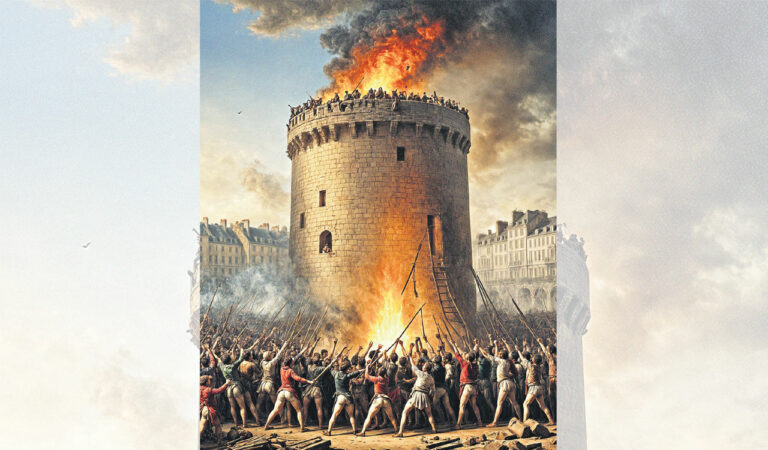Home | News | Rewind Vive La Republique Rewind: Vive la République One of the greatest events in the history of the world, the French Revolution began with the sack of Bastille on this day in 1789 By Telangana Today Published Date - 13 July 2024, 11:55 PM By KSS Seshan Exactly a month before India celebrates its Independence Day on August 15, France celebrates its National Day on 14 July every year. The French National Day, popularly known as Bastille Day, is a nationwide holiday marked with great pomp and pleasure. The event is celebrated with a grand annual military parade in Paris hailed as the oldest ongoing parade in the world.
The day is celebrated with fabulous fireworks at the Eiffel Tower on the banks of the Seine with high-profile international leaders and state guests. Across the country, citizens celebrate the day by waving the tricolour national flag and having parties with family and friends singing ‘La Marseillaise’, the French national anthem. In 2008, an Indian contingent of 400 soldiers participated in the military parade during their national day.

Last year, the Indian Prime Minister was the guest of honour at the festivities connected with Bastille Day in Paris. Louis XV was a ruthless king who could foresee the trouble that was brewing in the country. His statement “after me the deluge” aptly described the situation in France on the eve of the revolution The Bourbon Rulers The French National Day is not really about independence day to commemorate freedom from a different country.
In fact, the French were ruled by their own Bourbon dynasty during the time when the Mughals were the rulers in India. Founded by Henry IV, in 1589, the Bourbon dynasty was one of the prominent dynasties in Europe. Like the Hohenzollerns of Prussia, Habsburgs of Austria and Tudors in England, the Bourbons had a very long reign in France.
Though initially the dynasty had well-meaning kings like Henry IV and Louis XIII, the dynasty later produced several ruthless ones like Louis XIV and Louis XV who ruled the country as per the wishes of their queens and mistresses disregarding the ministers. At a time when Prussia was ruled by Frederick the Great, an enlightened monarch, who is reported to have gone on record saying “the King is not an absolute master of the people: but the first servant of the Nation”, in contrast, his contemporary Louis XIV in France, boasted, “I am the State”! (El etat c’est moi). That is why there was a revolution of such magnitude in France and not in Prussia.
A time arrives in the history of every nation when change becomes necessary and the question arises: how shall the change be brought about? The enlightened despots like Frederick of Prussia, Maria Theresa and Joseph II of Austria, Henry VII of England and Peter the Great of Russia with their benevolent rule changed the lives of their countrymen for the better and won their hearts. But when rulers become averse to the welfare of the people, the people themselves are forced to take the lead for such ‘change’. The dictatorial rule of the successive Bourbon kings in France invited trouble and the people of France had to resort to a Revolution to get rid of the archaic, barbaric ancien regime.
French Revolution, 1789 The revolution that occurred in France lasted for nearly a decade between 1789 and 1799, and was the most severe revolution in history. Known as the ‘Mother of all Revolutions’, the French Revolution violently put down monarchy, executed King Louis XVI along with his wife Marie Antoinette, scrapped all royal privileges and established a people’s government, abolished all social distinctions in favour of an egalitarian society, removed the obnoxious tax system and introduced a uniform national tax regime, issued assignats or paper currency. Above all, the revolution ensured liberty, equality and fraternity, which became its watchwords.
Because of the lofty aims and objectives of the revolution, the French Revolution is regarded as one of the greatest events in the history of the world. Louis XIV (1643- 1715) with his autocratic and imperial rule to a large extent contributed in no small measure to the French Revolution though it broke out later during the period of the innocent Louis XVI. He treated people as objects to pay taxes and do duties to the state.
He built a huge palace, the Versailles, at great expense spending people’s money. He waged several unnecessary wars with the neighbours spending large amounts of money. His successor Louis XV too was a ruthless king who could foresee the trouble that was brewing in the country.
Whether he said it or not, his statement “after me the deluge” aptly described the situation in France on the eve of the revolution. When rulers become averse to the welfare of the people, the people themselves are forced to take the lead for such ‘change’ as the French Revolution showed When the common people lived in poverty and starvation, the Bourbon kings lived in the gay surroundings of the glittering Versailles palace squandering the public money. The common people had all the duties to do and all taxes to pay while the nobles and the church people were exempted from any tax.
The common citizens “Serfs” lived a life of beasts supporting the three pillars of the state, the King, the Nobility and the Clergy. If at all France needed a powerful monarch to set the affairs in order and prevent any revolution, it was in 1774 when Louis XVI, a well-meaning lad of 20, succeeded to the French throne. Unfortunately, the new king lacked willpower and proved to be a puppet in the hands of his vivacious queen, Marie Antoinette, an Austrian princess.
Instead of rising to the occasion and putting down the revolution, he became a victim and was consumed by it. In 1793 at the height of the Revolution, he was guillotined by the revolutionaries. 14 July 1789 The sack of Bastille was one of the significant events in the initial phase of the French Revolution that was to continue for almost a decade between 1789 and 1799.
It was the first-ever violent act of the Parisian mob during the revolution. Bastille was, in fact, a Medieval fort on the outskirts of the capital, Paris. During the Bourbon regime, this fort with massive high walls with a deep moat and an imposing drawbridge was converted into a royal prison in which several poets, writers and intellectuals who spoke against the government were imprisoned “for life” as political prisoners, without any trial.
Bastille thus was a blot on the face of the nation. It was this Bastille which became the target for the people when they wanted to express their anger against the Bourbon administration. At a time when the people were demanding reforms and reduction of the tax burden, King Louis XVI on 11 July 1789 dismissed Finance Minister Jacques Necker who stood for reform.
Angry Parisians broke out in rebellion, attacked governmental establishments and looted arms and weapons all over the city. On 14 July, early morning, every able-bodied youth armed with muskets, swords or weapons, assembled and decided to give vent to their anger. Somebody shouted, “on to Bastille”.
Everyone, waving their arms, moved towards the Bastille. The Bastille prison at that time was guarded by jailer Launay and his 200 Swiss guards. The angry Paris mob scaled the outer walls of the prison, broke the drawbridge and stormed the Bastille from all sides.
In the melee, the jailer and his guards were killed. The severed head of Launay was placed on a pike and was carried off to be paraded in the streets of Paris. The fort prison was reduced to the ground.
The symbol of royal absolute monarchy, its authoritarianism and tyrannical reign was destroyed. Bastille disappeared with no trace of it. The triumphant Paris mob on the way back home shouted Vive la République making it clear that they craved a government by the people.
With the sack of Bastille, the long-drawn French Revolution began. Louis XIV followed what we generally term it as ‘Divine Right Theory of Monarchy’. He considered himself as the shadow of God on earth and exhorted people to obey him as they obeyed God The Sun King Louis XIV had one of the longest reigns in history.
Queen Elizabeth II of the United Kingdom came close to his reign but fell short by two years. (Her rule was for 70 years from 1952 to 2022). Born in 1738, Louis came to the throne when he was five years old in 1643.
He ruled for 72 years and died in his 77th year in 1715. It is said that he knew no day when he was not a king. He, therefore, had no time or inclination to get educated and remained ignorant of the history or geography of his own country.
However, during the later years, he lamented: “It is bitterly humiliating to be ignorant of things which everyone else knew.” Louis XIV followed what we generally term it as ‘Divine Right Theory of Monarchy’. He considered himself as the shadow of God on earth and exhorted people to obey him as they obeyed God.
To impress his people and the neighbouring countries, he assumed a number of high-sounding imperious titles like The Sun King, The First Gentleman of Europe, The Eldest Son of the Church and The Grand Monarch. He wanted to make his rule a reality. So after his minister, Mazarin, died in 1661, Louis XIV did not appoint any minister in his place and declared that he would be ‘his own Minister’.
His reign was marked by continuous wars, high taxation and an oppressive economic situation. Bastille, a medieval fort on the outskirts of Paris, became the target for the people when they wanted to express their anger against the Bourbon administration As the reigning king, Louis XIV reduced all his nobles to satellites and parasites. Prominent nobles were drafted to attend to him in his daily chores.
When the king got up from bed at 8.30 in the morning, about 150 nobles assembled and played music. An assigned nobleman handed over a towel to him when he washed his face or brushed his teeth.
What generally we wish to do in private, Louis XIV liked to do it in the presence of his nobles. Louis XIV was a voracious eater. He ate solidly three times a day and each time he ate, about 100 nobles assembled and watched him eating.
A few nobles felt honoured to bring the numerous dishes to the table. Some more were to taste them before the king ate to test whether his food was poisoned. He always ate alone under the gaze of his nobles and no one could share his table.
Due to constant overeating, he developed stomach disorders and it became necessary to take medicines. There was yet another prominent nobleman whose routine was to hand over the daily dose of medicine to the king. Palace of Versailles Though there were a number of royal palaces in and around Paris, Louis XIV, to display his pomp and splendour, decided to build a new palace worthy of his name.
He selected a site nearly 20 km west of Paris which he used to frequent for hunting in his youth. Construction began in 1661 and about 35,000 workmen were employed for the construction of the palace, the large garden around and the canals to bring water. The palace was on astronomical lines and the rooms went by the names of stars and planets.
There was one particular room known as the Hall of Mirrors which was about 170 feet in length and was studded with 17 large mirrors to match a similar number of windows. The mirrors were brought from Venice. This was the favourite room of the king.
Around the palace was the large garden where the most exotic plants and trees brought from all over Europe were planted with mathematical precision. Versailles with hundreds of rooms, anterooms and banquet halls amazed the contemporary world. The palace was so large that the king felt he and his queens were lost in the abode.
Therefore, the king invited all his nobles to the palace and made them his satellites. Several European countries unsuccessfully tried to replicate such a palace but refrained for fear of incurring the wrath of their people if such large sums were spent from their treasury. Louis XIV meticulously destroyed all the accounts on a daily basis as he never wanted others to know how much public money was spent on it.
Versailles soon became synonymous with reckless and conspicuous spending, extravagant living and luxury at its height. The palace virtually threw a wedge between the king and his people just before the French Revolution. (The author is a retired Professor of History at the University of Hyderabad) Follow Us : Tags Bastille Day French Revolution Vive la République Related News Opinion: Democratic ethos in new era Rewind: Living Lessons of a Revolution Jewels of France’s Queen Marie-Antoinette head to auction.



















